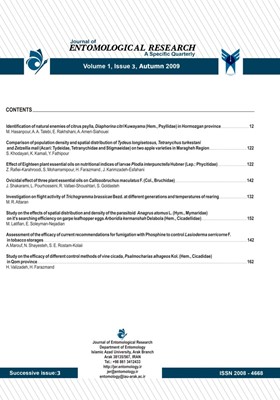Study on the effects of spatial distribution and density of the parasitoid Anagrus atomus L. (Hym., Mymaridae) on its searching efficiency on garpe leafhopper eggs Arboridia kermanshah Delabola (Hem.,
Subject Areas : entomology and othea arthropodsM. Latifian 1 * , E. Soleyman-Nejadian 2
1 - Date Palm and Tropical Fruits Research Institute, Ahwaz, Iran
2 - Plant Protection Department, Agricultural faculty, Shahid Chamran University, Ahwaz, Iran
Keywords:
Abstract :
Arboridia Kermanshah Delabola (Hem., Cicadellidae) is a dominant species of leafhoppers in vineyards of Isfahan, central region of Iran. The most abundant parasitoid of the leafhopper is Anagrus atomus in the region. This research was conducted to study the effects of the spatial distribution and density of the parasitoid and host on searching efficiency of parasitoid and parasitoid-host stability. Results showed a significant difference between host and parasitoid distribution on arms of vine trees. The highest density of parasitized and non-parasitized eggs of the leafhopper eggs were observed on leaves 7-12 in the middle of each vine arm. There was a significant density dependent relationship between host and parasitoid. Studying on the host and parasitoid density relationship showed that a high searching efficiency was observed in the first generation of host when the parasitoid density is low. The parasitoid searching efficiency was decreased by increasing the parasitoid density. When the parasitoid was leaving vineyard for wintering, the searching efficiency increased with decreasing in number of parasitoid. Interference coefficient (m) was higher when the parasitoid-host ratio was high and the searching efficiency decreased in this condition. The value of m was close to Q (searching constant) when the parasitoid-host ratio was high and host- parasitoid relationship was more unstable.

